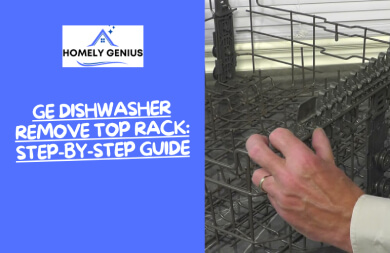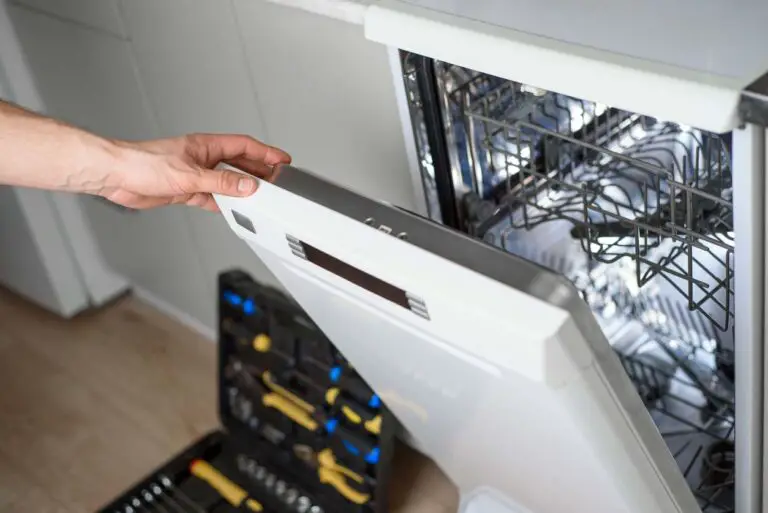GE Dishwasher Not Heating Or Drying? Common Reasons & Solutions

GE appliances have a good reputation. However, the majority of users experience heating malfunctions with GE dishwashers at least once during the machines’ lifetime. So, why is a ge dishwasher not heating or drying properly?
The main reason for a GE dishwasher not drying is a damaged heating element. However, the thermostat that controls this element can also be the cause. Other reasons include a faulty flood switch or a bad control board.
You must find the root cause of the trouble to fix your GE dishwasher properly. The following discussion provides the complete guide.
Troubleshooting And Fix For GE Dishwasher Not Heating Or Drying
Your GE dishwasher might not be drying the dishes for various reasons. A damaged heating element is often the first consideration. However, a clogged vent or malfunctioning thermostat can also have the same effect.
1. Heating Element Is Damaged
The heating element is a coil with high electrical resistance. It’s the main component for drying the dishes in your washer. Therefore, a damaged coil is the first thing that comes to mind when ge dishwasher not heating or drying.
You will find the heating element at the dishwasher’s bottom. It converts electrical energy into heat energy. This heat circulates throughout the dishwasher. Consequently, the water droplets on the utensils evaporate. Thus drying them up.
General wear and tear, corrosion, and mineral deposition can render the heating element dysfunctional. You can easily tell that from the rusty old appearance of the heating element.
Sometimes, power surges or voltage fluctuations can burn a heating element. The distinctive burnt smell is enough and is a good indicator of this. Improper or overloading of dishes can also cause this.
If the heating element coil is burnt or old, you must replace it.
First, turn off the dishwasher’s power supply. Then remove it from under the counter. Now, lay the washer on its back. You can now work on the heating element.
Connection spades and mounting hardware hold the heating element in place. Remove the connections and the mounting nuts. You can then reach in to remove the heating element from the dishwasher.
You can simply put in the new heating element and screw back the nuts and connections. Be sure to use a compatible GE dishwasher heating element. Usually they cost around $30-$50. Meanwhile, labor costs can be around $150-$300.
2. Clogged or Damaged Vent
You can usually find the vent on the dishwasher’s inner door panel. It circulates the heated air inside the washer and dries the dishes. So, if your heating element’s fine, a damaged vent should be your second consideration.
The vent does two things in the dishwasher. It maintains the hot air flow which evaporates the droplets. At the same time, it prevents the evaporated water from condensing and moisturizing the dish again.
These functions cease when the vent is blocked or stuck. As a result, you experience the ge dishwasher not heating or drying the dishes.
Some symptoms are a clear indication that your dishwasher’s vent is blocked. For instance, there will be water leakage and odor apart from wet dishes in the washer.
Usually, debris and grease build-up is the main reason for vent blockage. You can free it up using a soft brush. Use mild detergent or vinegar for more stubborn cases.
The only option for a damaged vent is replacement. You must remove the door panel to fully access the vent assembly. A set of screws secures the vent’s position. Remove those and the wirings to put in the new one.
A new GE dishwasher vent usually costs around $5-$10. However, you must hire a professional if you cannot perform the replacement yourself. They might charge you around $100-$150 for the job.
3. Malfunctioning High Limit Thermostat
If the heating element and vent are not the cause for trouble, then probably it’s the HL thermostat. The high-limit thermostat monitors the air and water temperature inside during wash cycles.
It will shut off the heating element when the temperatures have reached their safe limits (207F) for drying the dishes. Thus preventing a fire hazard or burned heating element.
However, a malfunctioning thermostat fails to detect this particular temperature. As a result, it might shut off the heating element too soon. Thus, you end up with wet dishes. On the other hand, it can not shut off the system at all and cause a disaster.
The high-limiting thermostat usually starts to malfunction when it has become too old. In that case, replace it as soon as possible before more damage occurs to your dishwasher.
You can find the high-limiting thermostat at the bottom of the dishwasher tub. This means it is close to the heating element, and you have to remove the bottom front access panel and toe panel to get it out.
Be sure to secure the new thermostat into the metal mounting bracket during the replacement. You should also take care to reconnect the wires properly. Use a compatible GE high-limiting thermostat for best results.
4. Bad Flood Switch
The flood switch cuts off the power supply when water levels are too high. Thus preventing flooding. Its location is the same as the heating element and the HL Thermostat- at the bottom of the dishwasher tub.
This system combines a tube, float, sensor, and a switch. The float is moveable inside the tube, and it raises with respect to the water levels. When the sensor detects the float crossing a certain point, it trips the switch and cuts off the power supply.
A fault in any part of the mechanism can result in water overflowing. As a result, you find wet dishes in your washer. Replacements can cost you $100-$150 in part and labor costs.
5. Faulty Control Board
No matter how good the other parts of the dishwasher are, it’s useless if you have a bad control board. The Control board controls the dishwasher’s various functions and settings.
It receives user input from the UI board. (These are the buttons and displays on your dishwasher.) Then, the control board communicates accordingly with the heating element and other systems.
Consistent use can wear down the control board. Thus rendering it unable to communicate with the systems effectively. However, you must ensure the User Interface board is in good shape before reaching a conclusion.
To access the control board for replacement, you have to separate the inner and outer door panels. Remove screws and housing that hold the board in place and put in the new one.
Diagnosing this problem and replacing the board is fairly technical. So, it’s best to seek professional help if you aren’t experienced. The cost of parts and labor might add up to $200.
FAQs
Hopefully, you have enough knowledge to tackle any heating issues in your GE dishwasher. Have more queries? Feel free to ask here.
Why is my GE dishwasher still not drying after fixing everything?
You might want to check your Cycle Selection. If you don’t select the ‘Heated Dry’ or ‘Heavy’ option, the GE dishwasher won’t dry the utensils effectively. Plus, ensure the washer isn’t packed too heavily.
Does the rinse aid affect the heating performance of the GE dishwasher?
The rinse aid liquid makes it easier and faster for the washer to clean and dry the dishes. Water can flow more effortlessly over the dishes when there is a rinse aid. So, if there isn’t enough rinse aid, the dishes might take longer to dry.
How long does the GE dishwasher’s heating element last?
Your GE dishwasher’s heating element can work fine for up to eight years. This applies to users who run five weekly cycles consistently during this period. However, poor maintenance and frequent power surges can lower the lifespan of your heating element.
Conclusion
A GE dishwasher not heating or drying can hamper your daily chores. So, try to keep in top shape by following simple maintenance routines.
For instance, clean the dishwasher regularly. You can easily do this by running cycles with two cups of vinegar. Also, avoid overstacking the washer.
Don’t wait for the dishwasher to completely shut down before you attend to its troubles. The sooner you address the problems, the lower your costs and the more chances you can save the dishwasher.


![How to Unlock Samsung Dishwashers [A Step-by-Step Guide]](https://homelygenius.com/wp-content/uploads/2023/11/how-to-unlock-samsung-dishwasher.jpg)



